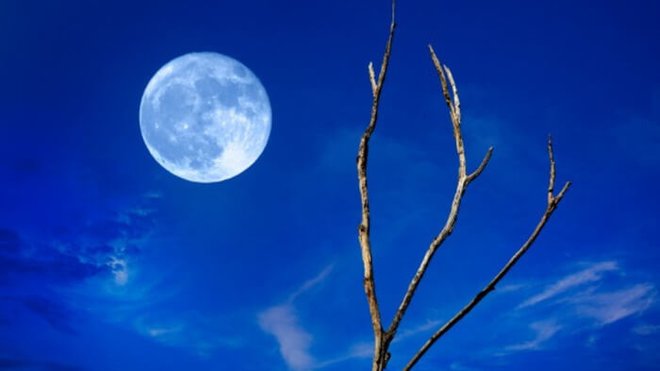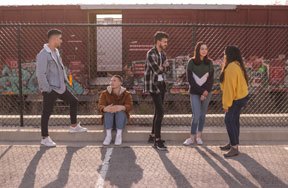October 2020’s Harvest & Halloween Full Moons
Fascinating facts about this month’s two full moons.
Oct 08, 2020Did you notice the huge, glowing Harvest Moon that lit up the night sky on October 1st? It was so bright, it actually seemed to be a full moon for about three days. If you missed it, no worries! This October is a blue moon month, which means two full moons are happening in one month. And how cool is it that the next full moon will be on Halloween? We’re closing the month of October with an extra-spooky full moon—The Hunter’s Blue Moon.
 Don't miss the rare full Hunter's Moon on his extra creepy Halloween.Courtesy of almanac.com
Don't miss the rare full Hunter's Moon on his extra creepy Halloween.Courtesy of almanac.com
The Hunter and the Harvest
The Harvest Moon is defined as the full moon that happens nearest to the Autumnal Equinox (September 22nd, 2020). The autumn moons become visible around sunset, giving off extra light earlier in the evening. Ages ago, farmers took advantage of the early autumn moonlight to harvest more crops before the approaching winter weather. Hence, the name “Harvest Moon.” The Hunter’s Moon is the full moon that directly follows the Harvest Moon. It was named for hunters who used the moonlight to hunt for food and prepare for winter. A full moon on Halloween has not been visible across all U.S. time zones since 1944, according to the Farmers' Almanac. It only happens every 18 or 19 years, and 2020 is one of them. Seems fitting for this crazy year! The next Halloween Full Moon won’t happen until 2039.
 The Harvest Moon and Hunter's moon were named after farmers and hunters who used the extra moonlight to get ready for winter.Courtesy of rd.com.
The Harvest Moon and Hunter's moon were named after farmers and hunters who used the extra moonlight to get ready for winter.Courtesy of rd.com.
White, orange, or blue?
Most years the Harvest Moon falls in September, but this year it falls in October. The moon at this time of year appears huge and is often orange, which are both illusions. It’s not larger--It just looks larger when it’s lower in the sky. The harvest moon doesn’t actually turn orange, and the blue moon isn’t blue. That orange hue comes from particles in the atmosphere, which your eyes have to look through more of since the moon is actually farther away when it’s closer to earth. And “blue moon” doesn’t refer to color at all, it’s just a term used to name a second moon that falls within the same month. Which doesn’t happen very often, by the way! It happens every 2.5 to 3 years—or “once in a blue moon.”
 The harvest moon often looks orange, but that's just an optical illusion.Courtesy of nasa.gov
The harvest moon often looks orange, but that's just an optical illusion.Courtesy of nasa.gov
 A “blue moon” doesn’t refer to color at all, it’s just a term used to name a second moon that falls within the same month. It happens every 2.5 to 3 years.Courtesy of almanac.com
A “blue moon” doesn’t refer to color at all, it’s just a term used to name a second moon that falls within the same month. It happens every 2.5 to 3 years.Courtesy of almanac.com
Full moon mythology & theories
The werewolf myth was born of the idea that full moons make everything a little crazier here on earth. Since ancient times, people believed full moons made people do erratic things. The words “lunacy” and “lunatic” come from the Roman goddess of the moon, Luna, who was said to ride her silver chariot across the dark sky each night. For thousands of years, even doctors have believed there is a link between the full moon and human behavior. Is there any truth to that? It depends on who you ask, but there’s no real evidence that full moons change people’s behavior. Although there is slightly more crime and more visits to the E.R. during a full moon, present day studies have debunked this theory. Regardless, many people still believe full moons make people act a little loony. Some also believe that more babies are born during full moons, although there’s little evidence to support it.
 Phases of the moon. When two full moons fall within one month, it's called a blue moon month.Courtesy of goodhousekeeping.com
Phases of the moon. When two full moons fall within one month, it's called a blue moon month.Courtesy of goodhousekeeping.com
That’s not to say that the moon doesn’t affect us at all here on earth. Its gravity is the reason for our ocean tides, pulling on them and causing them to bulge in its direction. One study found that it may be more difficult to sleep during a full moon, suggesting it may affect our internal clocks which control our sleep patterns. Some veterinarians even think it makes our pets do strange things.
 The moon's gravity is the reason for our ocean tides, pulling on them and causing them to bulge in its direction.Courtesy of timeanddate.com
The moon's gravity is the reason for our ocean tides, pulling on them and causing them to bulge in its direction.Courtesy of timeanddate.com
Full moon ritual
Rituals have been associated with the phases of the moon for thousands of years, and still exist today. For some full-moon fun, you can try this yourself. Full moon rituals encourage us to let go of whatever is in our lives that no longer serves us and to start fresh. If you’d like to try doing this, write down on a piece of paper what you want to release in your life, such as a bad habit. Then say out loud what you’ve written down, followed by, “I release you.” You can even do this outside under the moon if you want. Then discard the paper. If nothing else, the full moon ritual may inspire you to make a positive change in your life!
 Full moon rituals encourage us to let go of things that don't serve us well.Courtesy of rd.com
Full moon rituals encourage us to let go of things that don't serve us well.Courtesy of rd.com
Other astronomical happenings in October 2020
- On October 13th, look for a bright-red object rising in the early evening on the eastern horizon. Mars will lie in a perfect orbital alignment on that night, which means it will rise on the eastern horizon at the very moment that the sun is setting in the west and will stay in the sky until sunrise. The red planet won’t be that bright again for another 13 years.
- Between the October full moons is the Orionid meteor shower, which peaks the night of October 21st - 22nd. Between 10 and 20 meteors an hour are expected under ideal conditions.
- October 31stis the last day of daylight savings—So set your clocks back on Halloween night, before you go to bed!
 Watch for the Orionid meteor shower on the night of October 21st - 22nd.
Watch for the Orionid meteor shower on the night of October 21st - 22nd.
Share With Kidzworld
Do you find astronomy interesting? Tell us your thoughts in the space provided!

































